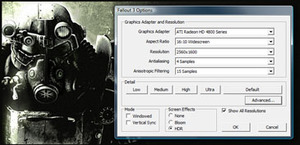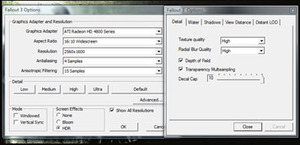
Fallout 3
Publisher: BethesdaFallout 3 is the revival of Interplay’s excellent Fallout series of games following many years out of the limelight. It’s developed and published by Bethesda and, judging by the success of the game, we’ll be seeing more Fallout games in the future.
Despite using the Oblivion engine which is now a few years old, the game looks absolutely stunning. Bethesda has spiced up the graphics a bit since Oblivion and has extended the engine – there are some great explosions, soft shadows and smoke effects that are particularly noteworthy.
We tested the game by manually playing a section of the game that incorporates a number of explosions and effects that you’re likely to experience during your time in post-apocalyptic Washington DC. We recorded the frame rate using FRAPS.
The in-game details were set to their highest values and both anti-aliasing and anisotropic filtering were controlled by the application settings instead of through the driver control panel. This meant that transparency anti-aliasing was enabled, along with HDR and all of the cool smoke effects.
Fallout 3’s engine is by default capped to 60 frames per second, which can make benchmark results very unclear, especially when testing at lower resolutions or with high end graphics cards. To remove the 60FPS cap you’ll need to find the Fallout3.ini file in \Documents\My Games\Fallout3 and edit the file so that iPresentInterval=0. This removes the frame rate cap, and allows us to get a much better idea of a card’s abilities.
Fallout 3
1,680 x 1,050 4xAA 16xAF, Maximum Detail
- Nvidia GeForce GTX 280 1GB SLI
- Nvidia GeForce GTX 295 1,792MB Quad SLI
- Nvidia GeForce GTX 295 1,792MB
- Nvidia GeForce GTX 260-216 896MB SLI
- ATI Radeon HD 4870 X2 2GB CrossFireX
- ATI Radeon HD 4870 1GB CrossFire
- ATI Radeon HD 4870 X2 2GB
- Nvidia GeForce GTX 280 1GB
- ATI Radeon HD 4870 1GB
- ATI Radeon HD 4870 512MB
- Nvidia GeForce GTX 260-216 896MB
-
-
83.3
-
58.0
-
-
-
82.6
-
53.0
-
-
-
82.5
-
58.0
-
-
-
81.6
-
57.0
-
-
-
80.9
-
53.0
-
-
-
80.7
-
56.0
-
-
-
80.5
-
49.0
-
-
-
70.9
-
37.0
-
-
-
70.9
-
33.0
-
-
-
64.0
-
30.0
-
-
-
62.4
-
32.0
-
0
10
20
30
40
50
60
70
80
90
Frames Per Second
-
Average
-
Minimum
Fallout 3
1,680 x 1,050 8xAA 16xAF, Maximum Detail
- Nvidia GeForce GTX 295 1,792MB Quad SLI
- Nvidia GeForce GTX 280 1GB SLI
- Nvidia GeForce GTX 295 1,792MB
- Nvidia GeForce GTX 260-216 896MB SLI
- ATI Radeon HD 4870 X2 2GB CrossFireX
- ATI Radeon HD 4870 1GB CrossFire
- ATI Radeon HD 4870 X2 2GB
- ATI Radeon HD 4870 1GB
- Nvidia GeForce GTX 280 1GB
- Nvidia GeForce GTX 260-216 896MB
- ATI Radeon HD 4870 512MB
-
-
82.1
-
47.0
-
-
-
81.3
-
48.0
-
-
-
81.2
-
50.0
-
-
-
80.9
-
46.0
-
-
-
80.8
-
45.0
-
-
-
80.3
-
49.0
-
-
-
79.4
-
48.0
-
-
-
66.9
-
27.0
-
-
-
59.7
-
29.0
-
-
-
52.4
-
23.0
-
-
-
44.7
-
13.0
-
0
10
20
30
40
50
60
70
80
90
Frames Per Second
-
Average
-
Minimum
Fallout 3
1,920 x 1,200 4xAA 16xAF, Maximum Detail
- Nvidia GeForce GTX 280 1GB SLI
- Nvidia GeForce GTX 295 1,792MB Quad SLI
- Nvidia GeForce GTX 260-216 896MB SLI
- Nvidia GeForce GTX 295 1,792MB
- ATI Radeon HD 4870 X2 2GB CrossFireX
- ATI Radeon HD 4870 1GB CrossFire
- ATI Radeon HD 4870 X2 2GB
- ATI Radeon HD 4870 1GB
- Nvidia GeForce GTX 280 1GB
- ATI Radeon HD 4870 512MB
- Nvidia GeForce GTX 260-216 896MB
-
-
82.7
-
49.0
-
-
-
82.4
-
46.0
-
-
-
81.3
-
48.0
-
-
-
81.3
-
45.0
-
-
-
80.5
-
44.0
-
-
-
80.3
-
48.0
-
-
-
79.5
-
46.0
-
-
-
64.7
-
30.0
-
-
-
64.1
-
32.0
-
-
-
61.5
-
25.0
-
-
-
55.6
-
28.0
-
0
10
20
30
40
50
60
70
80
90
Frames Per Second
-
Average
-
Minimum
Fallout 3
1,920 x 1,200 8xAA 16xAF, Maximum Detail
- Nvidia GeForce GTX 295 1,792MB Quad SLI
- Nvidia GeForce GTX 280 1GB SLI
- ATI Radeon HD 4870 X2 2GB CrossFireX
- Nvidia GeForce GTX 295 1,792MB
- ATI Radeon HD 4870 1GB CrossFire
- ATI Radeon HD 4870 X2 2GB
- Nvidia GeForce GTX 260-216 896MB SLI
- ATI Radeon HD 4870 1GB
- Nvidia GeForce GTX 280 1GB
- Nvidia GeForce GTX 260-216 896MB
- ATI Radeon HD 4870 512MB
-
-
81.8
-
39.0
-
-
-
80.8
-
48.0
-
-
-
79.8
-
44.0
-
-
-
79.1
-
41.0
-
-
-
79.1
-
45.0
-
-
-
78.9
-
40.0
-
-
-
78.5
-
43.0
-
-
-
62.0
-
24.0
-
-
-
55.6
-
23.0
-
-
-
48.7
-
18.0
-
-
-
35.1
- 6.0
-
0
10
20
30
40
50
60
70
80
90
Frames Per Second
-
Average
-
Minimum
Fallout 3
2,560 x 1,600 0xAA 16xAF, Maximum Detail
- Nvidia GeForce GTX 295 1,792MB Quad SLI
- Nvidia GeForce GTX 280 1GB SLI
- Nvidia GeForce GTX 295 1,792MB
- Nvidia GeForce GTX 260-216 896MB SLI
- ATI Radeon HD 4870 1GB CrossFire
- ATI Radeon HD 4870 X2 2GB CrossFireX
- ATI Radeon HD 4870 X2 2GB
- Nvidia GeForce GTX 280 1GB
- ATI Radeon HD 4870 1GB
- Nvidia GeForce GTX 260-216 896MB
- ATI Radeon HD 4870 512MB
-
-
82.7
-
45.0
-
-
-
82.3
-
49.0
-
-
-
81.9
-
48.0
-
-
-
81.7
-
47.0
-
-
-
80.4
-
50.0
-
-
-
80.1
-
43.0
-
-
-
79.5
-
45.0
-
-
-
64.7
-
32.0
-
-
-
59.7
-
30.0
-
-
-
59.0
-
30.0
-
-
-
57.5
-
24.0
-
0
10
20
30
40
50
60
70
80
90
Frames Per Second
-
Average
-
Minimum
Fallout 3
2,560 x 1,600 4xAA 16xAF, Maximum Detail
- Nvidia GeForce GTX 295 1,792MB Quad SLI
- Nvidia GeForce GTX 280 1GB SLI
- ATI Radeon HD 4870 X2 2GB CrossFireX
- Nvidia GeForce GTX 295 1,792MB
- ATI Radeon HD 4870 X2 2GB
- ATI Radeon HD 4870 1GB CrossFire
- Nvidia GeForce GTX 260-216 896MB SLI
- Nvidia GeForce GTX 280 1GB
- ATI Radeon HD 4870 1GB
- Nvidia GeForce GTX 260-216 896MB
- ATI Radeon HD 4870 512MB
-
-
81.9
-
44.0
-
-
-
80.1
-
43.0
-
-
-
79.6
-
43.0
-
-
-
77.8
-
41.0
-
-
-
77.5
-
37.0
-
-
-
77.3
-
32.0
-
-
-
77.0
-
36.0
-
-
-
52.0
-
24.0
-
-
-
51.5
-
20.0
-
-
-
45.7
-
19.0
-
-
-
27.6
- 2.0
-
0
10
20
30
40
50
60
70
80
90
Frames Per Second
-
Average
-
Minimum
Fallout 3
2,560 x 1,600 8xAA 16xAF, Maximum Detail
- ATI Radeon HD 4870 X2 2GB CrossFireX
- ATI Radeon HD 4870 1GB CrossFire
- Nvidia GeForce GTX 295 1,792MB Quad SLI
- ATI Radeon HD 4870 X2 2GB
- Nvidia GeForce GTX 280 1GB SLI
- Nvidia GeForce GTX 295 1,792MB
- Nvidia GeForce GTX 260-216 896MB SLI
- ATI Radeon HD 4870 1GB
- Nvidia GeForce GTX 280 1GB
- Nvidia GeForce GTX 260-216 896MB
- ATI Radeon HD 4870 512MB
-
-
77.6
-
26.0
-
-
-
75.6
-
25.0
-
-
-
75.1
-
24.0
-
-
-
73.6
-
23.0
-
-
-
70.0
-
27.0
-
-
-
50.6
-
18.0
-
-
-
47.7
-
16.0
-
-
-
46.5
-
15.0
-
-
-
39.8
-
13.0
-
-
-
31.3
-
8.0
-
-
- 1.5
- 0.0
0
10
20
30
40
50
60
70
80
Frames Per Second
-
Average
-
Minimum
While Fallout 3 is a demanding modern game, when faced with the graphics crunching power of multiple GPU solutions, be they on a single or multiple cards, performance quickly becomes limited elsewhere. Every multi-GPU solution, be it dual or quad GPU, performs within just a few frames of each other in almost every test as performance bottlenecks. The GTX 295 placed exactly where we'd expect it to be between SLI GTX 260-216 and SLI GTX 280, with all three performing within just a few frames per second of each other.
That is until we reach the absolute highest resolution with the absolute highest anti-aliasing settings support by the game. At 2,560 x 1,600 with 8xAA the GTX 295 falls a long way short of ATI's dual GPU Radeon HD 4870X2 and is a full 20 frames per second slower than SLI GTX 280s. Switching to a quad GPU setup soon redresses this, but dual 4870X2s still have a slight edge.











Want to comment? Please log in.